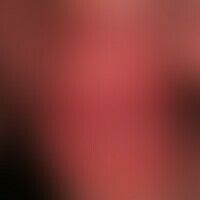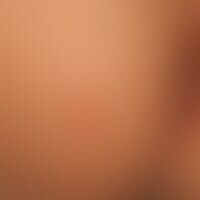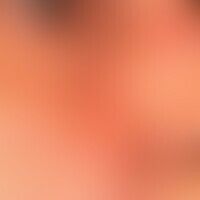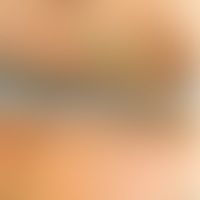Image diagnoses for "red"
875 results with 4455 images
Results forred

Sweet syndrome L98.2
Dermatosis, acute neutrophils: reddish-livid, succulent, pressure-dolent, infiltrated, solitary and partly confluent papules, which confluent to plaques. 1 week before the onset of the disease a fever attack with temperatures > 38 °C occurred.

Bowen's disease D04.9
Bowen's disease: Chronically stationary, slowly increasing in area and thickness, sharply defined, meanwhile clearly increased in consistency, symptomless, red, rough, partly scaly, partly erosive, partly crusty plaques on the left thumb extension side of a 63-year-old man; characteristic is the occurrence mainly in the area of light-exposed skin areas.
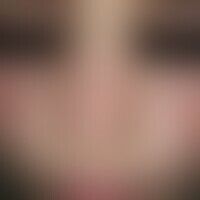
Hydroa vacciniforme L56.8
Hidroa vacciniformia: Occurrence of pinhead-sized, partially umbilical vesicles with serous content in the region of the bridge of the nose in an 8-year-old boy after UV exposure.
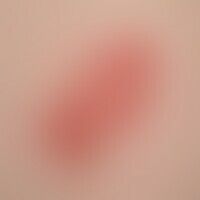
Bowen's disease D04.9

Zoster B02.9
Zoster: Acute segmental zoster; multiple papules and paplu-vesicles extending beyond the segment.
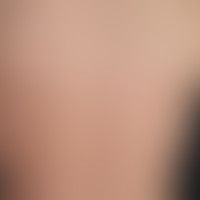
Lupus erythematosus (overview) L93.-
Lupus erythematosus, subacute cutaneous lupus erythematosus: acute episode of non-scarring cutaneous lupus erythematosus, known significantly increased photosensitivity.

Melanoma acrolentiginous C43.7 / C43.7
melanoma malignes acrolentiginous. dark discoloration of the right small toe existing for years. growth of thickness for 1/2 year, discoloration increasingly decreasing. now: largely amelanotic, centrally ulcerated and macerated nodule at the 5th toe. remark: treated as mycosis for several months.
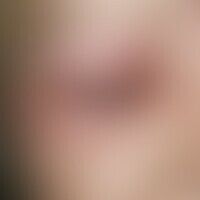
Dermatitis contact allergic L23.0
Dermatitis contact allergic: Multiple (both eyelid regions affected), acute, blurred, low consistency, itchy and burning, red, slightly moist plaques.
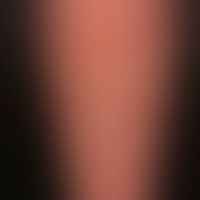
Prurigo simplex subacuta L28.2
Prurigo simplex subacuata: typicaldistribution pattern of the interval-like itchy, scratched, inflammatory papules and plaques; small atrophic scars are also visible.

Hand-foot-mouth disease B08.4
Hand-Foot-Mouth Disease: since about 1 week, painful, blisters, pustules and papules on hands and feet, about 1-2 weeks before, unspecific flu-like prodrome.

Anal dermatitis (overview) L30.8
Anal eczema: chronic "eczematous" changes of the perianal region with known atopic diathesis.
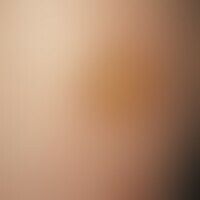
Culicosis bullosa T00.96
Culicosis bullosa. unusually large blister formation after a mosquito bite on the lower leg of an 18-year-old woman. Typical is the "sudden" blister formation on otherwise unchanged skin.

Artifacts (overview) L98.1
artifacts: greasy crusty covered flat ulcers. no indication of acne. no indication of other organ diseases

Vascular malformations Q28.88
Malformations vascular: Non-syndromal capillary malformation (naevus flammeus/port-wine stain)
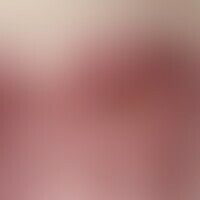
Zoster B02.9
Zoster. 68-year-old female patient with blistering disease. For three days pain, erythema and subsequently formation of blisters occurred. Smallest, partly isolated, partly grouped blisters on e-rythematous skin which in places have merged to larger aggregates. In the picture at the top right two larger, partly hemorrhagic blisters are visible.
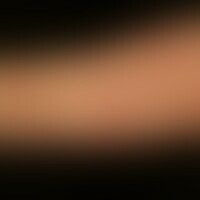
Lupus erythematosus acute-cutaneous L93.1
lupus erythematosus acute-cutaneous: clinical picture known for several years, occurring within 14 days, at the time of admission still with intermittent course. anular pattern. in the current intermittent phase fatigue and exhaustion. ANA 1:160; anti-Ro/SSA antibodies positive. DIF: LE - typical.
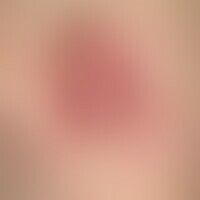
Dermatofibrosarcoma protuberans (overview) C44.-
Dermatofibrosarcoma protuberans: For many years a persistent, slowly growing, very coarse, bumpy, skin-coloured to reddish tumour on the left shoulder of a 61-year-old female patient.
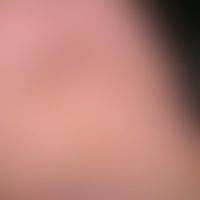
Tinea pedis oligosymptomatic type B35.30
Tinea pedis oligosymptomatic type: no subjective sympotaxis. findings rather coincidental. circinar, grazing scaling. typical are raised scaling ruffs of the areas (marked by arrows). small plantar wart marked by circle, positive mycological evidence in the zone of the small toe marked by square.
